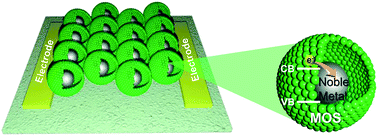Noble metal@metal oxide semiconductor core@shell nano-architectures as a new platform for gas sensor applications
Abstract
Among the complex nanostructures, core@shell nanomaterials are gaining much attention, as the physical properties of the core and shell can be easily and separately tuned. Two materials in the form of core@shell nanostructures combine their individual properties and also bring unique properties in comparison with single-component materials. Recently, the formation of core@shell nanoparticles (NPs) having noble metals (Au, Ag, Pt and Pd) as a core and metal oxides semiconductors (TiO2, SnO2, and Cu2O) as a shell has attracted immense research interest in sensing, photo-catalysis, dye-sensitized solar cells and so on due to tailorability and functionality in the core and shell. Therefore, an overview of the advances in this exciting field of noble metals@metal oxides core@shell NPs has been presented in this feature article. It includes systematic synthesis approaches of noble metal@metal oxide core@shell NPs and their applications in the field of gas sensors, which is based on the literature and our own recent work. The synthesis of core@shell NPs with controllable sizes, compositions, morphologies, structures and functionalities has been presented considering the advantages and the demerits of the process. Applications of these core@shell NPs in the areas of gas sensing and their sensing mechanisms are discussed. The future prospects of such core@shell nanostructures for gas sensing applications are also highlighted.


 Please wait while we load your content...
Please wait while we load your content...